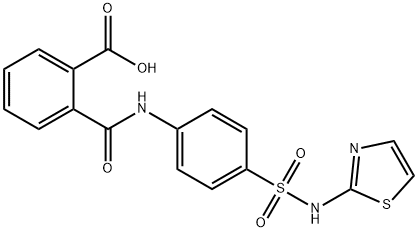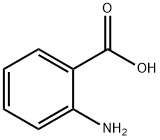Phthalylsulfathiazole
Synonym(s):PST;STP;P-PST;STP1;TSPST1
- CAS NO.:85-73-4
- Empirical Formula: C17H13N3O5S2
- Molecular Weight: 403.43
- MDL number: MFCD00005318
- EINECS: 201-627-4
- SAFETY DATA SHEET (SDS)
- Update Date: 2025-12-16 16:15:04

What is Phthalylsulfathiazole?
Chemical properties
White or yellowish-white, crystalline powder.
Originator
Sulfathalidine, MSD, US,1946
The Uses of Phthalylsulfathiazole
Phthalylsulfathiazole is a sulfonamide antibacterial drug with similar and stronger effects than Sulfaguanidine and Succinylsulfathiazole. It is rarely absorbed orally and slowly decomposes in the intestine to release Sulfathiazole and exert intestinal antibacterial effects, and is used in the treatment of dysentery, colitis, and gastroenteritis.
Background
Phthalylsulfathiazole is a broad spectrum antibiotic which is part of the drug class, sulfonamides. It was used as an antibiotic for bowel surgery, and for infections of the colon .
Definition
ChEBI: Phthalylsulfathiazole is a sulfonamide incorporating 2-carboxybenzamido and 1,3-thiazol-2-yl moieties that is a broad-spectrum antibiotic indicated in the treatment of dysentery, colitis, gastroenteritis and intestinal surgery. It is a sulfonamide, a member of 1,3-thiazoles, a dicarboxylic acid monoamide and a sulfonamide antibiotic. It derives from a phthalic acid.
Preparation
It may be prepared by the interaction of sulfathiazole and phthalic anhydride in equimolar proportions.
It exerts its bacteriostatic effect in the gastro-intestinal tract. It has been found to be twice as active as sulfaguanidine in the treatment of bowel irregularities. It is often effective in watery diarrhoeas and ulcerative colitis. It is also used in the pre-operative treatment of patients undergoing surgery of the intestinal tract. It may also be recommended in the treatment of acute bascillary dysentry of the Sonne, Flexner and Shiga species.
Manufacturing Process
5 g of phthalic anhydride was added to a boiling suspension of 10 g of sulfathiazole in 100 cc of alcohol. The mixture was then refluxed for 5 minutes after the addition was complete at which time all of the solids were in solution. The solution was then cooled and diluted with an equal volume of water, The white solid precipitate which formed was filtered and recrystallized from dilute alcohol, yielding 2-N4-phthalylsulfanilamidothiazole,which decomposes above 260°C, according to US Patent 2,324,015.
brand name
Canidis-anti-diarr;Carbidiar;Carbotalin;Colicitina;Coliclase;Crematalil;Diacolin;Direver;Disenterol;Ef-micin;Enterocalme;Entero-hermes;Entero-red;Enterosteril;Entero-toxan;Esteraplidin mag;Eugeniteed;Fitazil;Ftalil-tiazol;Ilentazol;Inrestibla strepto;Iodentero-neomicina;Logical;Massotalil;Neo-sulfazon;Novosulfina;Phtazol;Septiftalil;Syptan;Talisulfazol;Tamil;.
Therapeutic Function
Antibacterial (intestinal)
World Health Organization (WHO)
Phthalylsulfathiazole, a sulfonamide anti-infective agent, was introduced in 1946 for the treatment of bacterial infections. The importance of sulfonamides has subsequently decreased as a result of increasing bacterial resistance and their replacement by antibiotics which are generally more active and less toxic. Although phthalylsulfathiazole, which is poorly absorbed from the gastrointestinal tract, is no longer recommended in some countries, it continues to be used in others for the treatment of local intestinal infections, including bacterial dysentery, and for pre-operative bowel preparation.
Flammability and Explosibility
Non flammable
Metabolism
Not Available
Mode of action
Phthalylsulfathiazole is of low inherent toxicity. Besides, it also enjoys an additional plus point for being only slightly absorbed by the intestinal mucosa ; and, therefore, may be safely administered in comparatively large doses in the management and treatment of bacillary infections of the intestine. The drug is not absorbed orally and is mostly employed for ulcerative colitis.
Properties of Phthalylsulfathiazole
| Melting point: | 198-204°C |
| Boiling point: | 371.31℃[at 101 325 Pa] |
| Density | 1.4235 (rough estimate) |
| vapor pressure | 0Pa at 25℃ |
| refractive index | 1.6390 (estimate) |
| storage temp. | Keep in dark place,Sealed in dry,Room Temperature |
| solubility | Practically insoluble in water, freely soluble in dimethylformamide, slightly soluble in acetone and in ethanol (96 per cent). |
| form | neat |
| pka | 3.40±0.36(Predicted) |
| form | Solid |
| color | White to Light Yellow |
| Water Solubility | 400mg/L at 28℃ |
| Merck | 14,7377 |
| BRN | 359901 |
| CAS DataBase Reference | 85-73-4(CAS DataBase Reference) |
| NIST Chemistry Reference | Phthalylsulfathiazole(85-73-4) |
| EPA Substance Registry System | Benzoic acid, 2-[[[4-[(2-thiazolylamino)sulfonyl]phenyl]amino]carbonyl]- (85-73-4) |
Safety information for Phthalylsulfathiazole
| Signal word | Danger |
| Pictogram(s) |
 Exclamation Mark Irritant GHS07  Health Hazard GHS08  Environment GHS09 |
| GHS Hazard Statements |
H412:Hazardous to the aquatic environment, long-term hazard |
| Precautionary Statement Codes |
P273:Avoid release to the environment. P501:Dispose of contents/container to..… |
Computed Descriptors for Phthalylsulfathiazole
Phthalylsulfathiazole manufacturer
New Products
Indole Methyl Resin tert-butyl 9-methoxy-3-azaspiro[5.5]undecane-3-carboxylate Boc-His(Boc)-OH 2-CTC Resin 4-Chloro-7-tosy1-7Hpyrrolo[2,3-d]pyrimidine 5,7-Dibromo-1H-indole 2,5-dichloro-N-hydroxy-4,6-dimethylpyridine-3-carboximidamide 2,2-Dimethoxy-7-azaspiro[3.5]nonane hydrochloride 4-chloromethyl-5-methyl-1,3-dioxol-2-one (DMDO-Cl) R-2-BENZYLOXY PROPIONIC ACID 1,1’-CARBONYLDIIMIDAZOLE 1,1’-CARBONYLDI (1,2-4 TRIAZOLE) N-METHYL INDAZOLE-3-CARBOXYLIC ACID 4-((2-hydroxyethyl)thio)benzoic acid 1-(TERT-BUTOXYCARBONYL)-2-PYRROLIDINONE Methyl 6-methylnicotinate 3-Pyridineacrylic acid tert-Butyl carbazate TETRAHYDRO-2H-PYRAN-3-OL 2-((4-morpholinophenylamino) (methylthio) methylene) malononitrile 3-(4-morpholinophenylamino)-5-amino-1H-pyrazole-4-carbonitrile 2,4-dihydroxybenzaldehyde 1,3-Diethyl-1,3-Diphenylurea Methyl 2-methylquinoline-6-carboxylateRelated products of tetrahydrofuran








You may like
-
 Phthalylsulfathiazole CAS 85-73-4View Details
Phthalylsulfathiazole CAS 85-73-4View Details
85-73-4 -
 Anti-SULT1A1 antibody produced in rabbit CASView Details
Anti-SULT1A1 antibody produced in rabbit CASView Details -
 Anti-SULT1A1 antibody produced in rabbit CASView Details
Anti-SULT1A1 antibody produced in rabbit CASView Details -
 Anti-ST8SIA4 antibody produced in rabbit CASView Details
Anti-ST8SIA4 antibody produced in rabbit CASView Details -
 Anti-ST8SIA4 antibody produced in rabbit CASView Details
Anti-ST8SIA4 antibody produced in rabbit CASView Details -
 Phthalylsulfathiazole CAS 85-73-4View Details
Phthalylsulfathiazole CAS 85-73-4View Details
85-73-4 -
 Pyridine 99.5% HPLC /UV SpectroscopyView Details
Pyridine 99.5% HPLC /UV SpectroscopyView Details
110-86-1 -
 Thiourea 99% ARView Details
Thiourea 99% ARView Details
62-56-6
